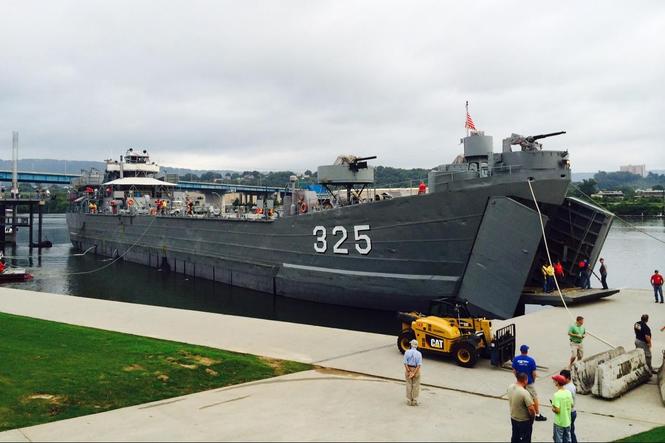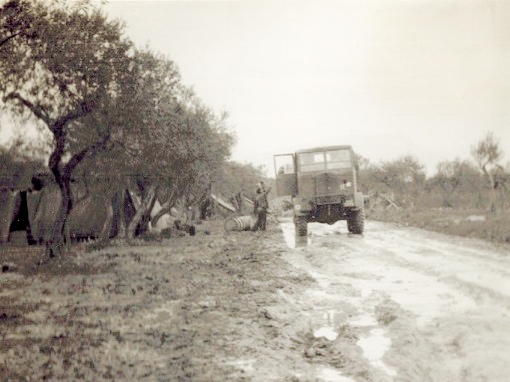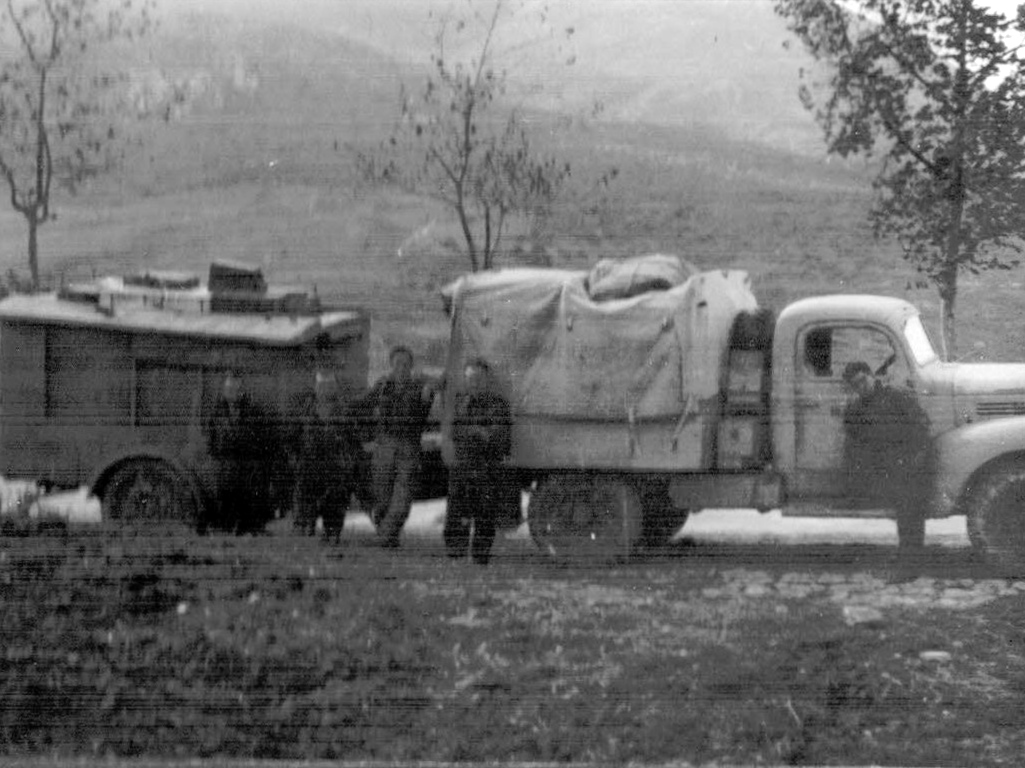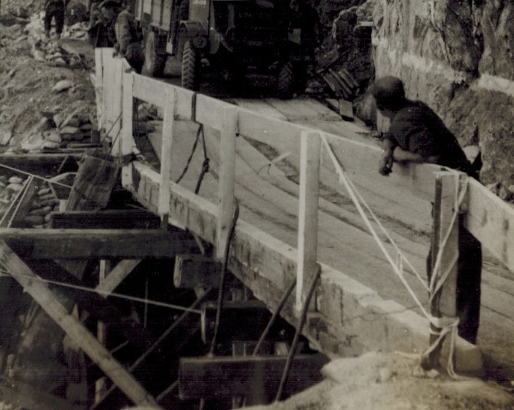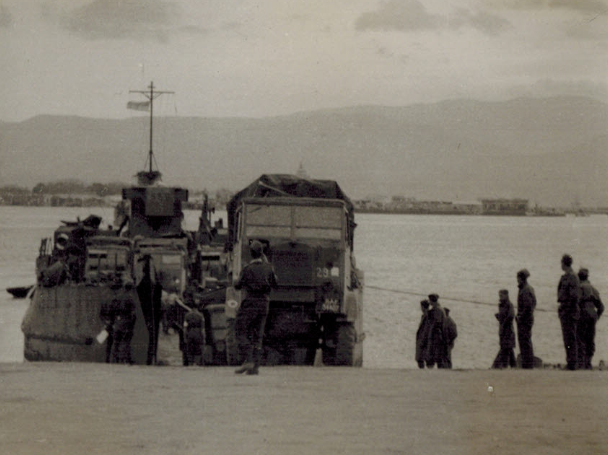Although the squadron did not relocate from Tunisia to Sicily until the middle of August 1943, operational flying over and to the north of Sicily is reported in the ORB as having commenced in the early hours of 1 August, with immediate success. Flight Sergeant Cameron (Pilot) and Pilot Officer Hood (Navigator Radio) bagged a Ju.88 at first light (05:20) with the benefit of GCI control by 'Garnet'. On returning to Tunisia with only one engine working, the Beaufighter had to divert to La Sebala I on account of its own base being fogbound.
[1]
[2]
That same day an advance party of 17 "Other Ranks" left for Sicily, under the command of the squadron’s Codes and Cyphers Officer, 125365 Flying Officer George Henry Roker. Records of the movement of the Advance Party was not added to the ORB until the 11th, at which juncture it is noted that they were held at the "Arizona" Staging Camp until the late evening of the fourth, then boarding His Majesty’s Landing Ship (Tanks) LST 331 which sailed from La Goulette on the fifth, arriving at Palermo 16:30 on the sixth. Having unloaded their two vehicles they spent the night at another Staging Camp, proceeding to Bo Rizzo where they arrived 10:30 on the ninth having spent one night camped in the hills en route.
[3]
|
Care needs to be taken when identifying the Bo Rizzo site today. It was inland, not the coastal site of the modern Trápani airport.[4] That said, when approaching the modern airport to land on runway 31L[5] the remains of Bo Rizzo are clearly visible on the starboard side and can also be seen on Google Earth at 37°53'45"N, 12°32'20"E. Prior to WWII the Italian airforce operated two airbases in the area – one called Trápani-Milo near the foot of Monte Erice and a larger one at Chinisia (also known as Kinisia) near Marausa. Both became operational bases for the Luftwaffe and were subjected to heavy Allied bombardment as a result. Immediately after Operation Husky in July 1943, the US Army Air Force took over Kinisia and temporarily renamed it Borizzo Airfield - itself a corruption of the name assigned to the airport by the Allies. The Kinisia name was restored in 1944.[6]
|
| 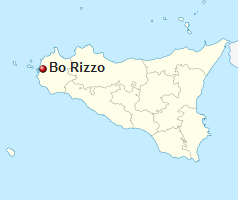
Location map for Bo Rizzo, Sicily.
[Map template : Wikipedia] |
At Bo Rizzo the advance party selected suitable locations for dispersal and then set up camp. On the eleventh, according to the ORB, the party was joined by a "F/Lt. Sectem"
[7] who instructed Flying Officer Roker to take a flarepath to Castelvetrano for emergency use.
Meantime the main Sea Party were following much the same route, using LST 325, the exception being that this second LST anchored "in the bay" off La Goulette for a day before setting course for Sicily in a convoy. This enabled strong swimmers to enjoy some deep sea bathing.
[8]
Not mentioned in the official record but prominently included in the unofficial diary was a diplomatic gaffe that took place during embarkation. In respect of Wilbur Wright’s efforts at directing what he surmised to be the proper loading of the LST, the diary records:
...an American officer drew up in a jeep. He was promptly told where to take the jeep. Later, when the Squadron’s vehicles were all safely stowed the American naval chappie was allowed by Wilbur to park his jeep in a small space for which the Squadron had no use. It turned out afterwards that the officer was merely Captain of the ship...[9]
The American naval officer is currently presumed to have been Clifford Eugene Mosier.
[10]
By the evening of the 17th everybody had arrived at Bo Rizzo, completing the move. Operational readiness was declared effective from the night of 17/18 August 1943, although the site’s telephones were not functional until the following day.
[11]
The LSTs used by the Squadron as sea transport were sizeable vessels, not to be confused with the much smaller LCTs (Landing Craft, Tanks) the Squadron later used to cross the Straits of Messina. 99.97m length and 15.24m beam, LSTs had a displacement of around 1700 tonnes unladen and could cruise at 12 knots. LST 305 is reported to have been torpedoed and sunk by U230 off Anzio and it seems that LST 331 was broken up for scrap in 1948.
[12] But LST 325 sails on. We do not have any surviving aircraft from the squadron, or the liner RMS Maloja, but good old LST 325 is still with us, acquired from the Greek Navy by the
USS LST Memorial Association Inc., sailed across the Atlantic during the winter of 2000/2001 by a volunteer crew of 29 people with an average age of 72, refurbished from stem to stern and now plying the inland waterways of the United States as a floating museum. Here’s a photograph of her docking in Chattanooga, Tennessee in September 2014:
On 27 August, 420086 RAAF Flight Sergeant Robert Reginald Waddell, attached from RDF Calibration flight, Blida (Algeria), in Beaufighter Mk.II V8187, was the victim of a "Friendly Fire" incident - shot into the sea by five American Spitfires, 5 miles east of Scopella. Both the pilot and 409215 RAAF Flight Sergeant Francis Arthur Noonan on detachment from No.40 Squadron were killed.
[13]
Much effort seems to have been expended during the latter part of August chasing mail and exchanging currency, especially as regards obtaining enough "BMA Lire". It is unclear at present whether this referred to the BMA (British Military Authority) banknotes issued for Tripolitania in Lire denominations in 1942, or whether there was a new currency issue for Italy itself as opposed to one of its former colonies. Further research is needed to clarify this point.
August’s aerial activity consisted primarily of checking out the true identity of Allied bomber aircraft returning at night from missions further north, to ensure that no enemy aircraft were sneaking in amongst the 'friendlies'. A terse comment in the Form 541 entry for the night of 19/20 August notes that badly worded R/T traffic originated by Garnet gave away the maximum range of the relatively new and most definitely secret Mk.VIII centimetric radar.
[14] Whether this leak was ever intercepted/interpreted by German Military Intelligence is at present unknown.
The same Form 541 also refers to a 'Bogey' chased on the night of 20/21 and eventually identified visually as a Hudson burning
Resin Lights by way of identification. The implication is that the Hudson was not using its IFF.
Resin Lights were a visual form of night time air-to-air "I'm friendly!" identification, displaying a two-colour code which typically changed daily. The colours were altered by manual exchange of "resin" (plastic) filters; one more job for the ground crew. Many aircrew were reluctant to use IFF because the signal it transmitted could equally be used by enemy aircraft and ground stations to track their movements. For this reason, orders were to switch IFF on only when returning to friendly airspace, never on the outward leg and not whilst in hostile airspace. Fine for bombers returning from attacks further north, but the Hudson in this scenario could well have been a Coastal Command aircraft of No.608 Squadron on anti-submarine patrol, protecting Allied shipping in Palermo Bay and flying out of Protville in Tunisia.
[15] They would have had good cause to maintain electronic warfare silence; negligent failure to activate IFF should not be assumed.
The first half of September was busy, many of the Squadron’s patrols having the objective of excluding Axis medium bombers from the skies over the Allies’ invasion of mainland Italy. The rest of September and the whole of October was, by comparision, quiet.
The whole Italian campaign was fast-moving at this point, the main invasion force landing at Salerno (Operation Avalanche, 3–17 Sep 1943) with supporting actions in Calabria (Operation Baytown) and Taranto (Operation Slapstick). This coincided with the somewhat premature disclosure by General Eisenhower on 8 September that the Italians had signed an unconditional armistice with the Allies, in effect changing sides in the war. Mussolini was already imprisoned, but on 12 September he was 'sprung' from the Campo Imperatore Hotel on the summit of the Gran Sasso mountain by a German commando unit led by SS-Standartenführer (Colonel) Otto Skorzeny and taken to Germany as the culmination of a spectacularly successful mission called
Unternehmen Eiche (in translation Operation Oak).
Before midnight on the night of the 06/07 September, Flying Officer H.K. Humphreys (Pilot) and F/Sgt. P.A. Robertson (Navigator Radio) suffered an R/T failure whilst 47 miles / 330° from the island of Ustica – well over the Tyrrhenian Sea and in potentially hostile airspace. The ORB entry is critical of the failure of "Doorkey" to notify either "Speedboat" (local control) or the Squadron that "43" (meaning aircraft callsign Rutbah 43) might be in difficulty. Fortunately the Beaufighter’s crew found their own way home.
Similarity of appearance of hostile and friendly aircraft continued to be problematic. "Farmer" Giles and "Quack" Drake had particular difficulty with a target encountered during the night of 07/08 September, when (from a position beneath the 'bogey') they found themselves unable to distinguish by silhouette alone between a Mitchell and a Dornier Do.217. The uncertainty resolved only when they positioned themselves such that they could see the glow of the engine exhausts, a distinguishing feature. The Do.217 was duly shot down.
The Form 541 for the night of 09/10 September includes considerable detail of the problems of mixed radar and IFF systems. Some sort of "Friendly Fire" attack took place, Rutbah 43 (Humphries and Robertson) landing with aircraft damage clearly caused by 20mm cannon and .303 inch machine gun fire. No.600 Squadron, operating in the same general area, were equipped with Mk.IIG IFF which was invisible to both 255 Squadron’s AI and their Adlux GCI Controller (8015 AMES). Conversely, 600’s Beaufighters could not see 255’s IFF. The Beaufighter of 255 Squadron was declared "Cat A" but the crew were unhurt. The re-equipping of 255 in Tunisia, ensuring that all aircraft within the squadron had compatible radar and IFF, had failed to eliminate the possibility of other RAF Squadrons mis-identifying them in the dark.
Also notable was an event in daylight on 26 September, when two Beaufighters of the Squadron apparently collided in mid-air. The one flown by 120493 Flying Officer Jimmy Ward reported only a slight jolt, but the one piloted by 404992 RNZAF Warrant Officer David Keith Cotterill with 138211 RAFVR Flying Officer Dewi Marlais Nedahl as Navigator Radio crashed into the sea some 10 miles west of Cap S.Vito. That aircraft and its crew were lost; Ward and his navigator Flight Sergeant E.G. Marsden successfully returned to base. Persistent rumours of there having been two passengers aboard the lost Beaufighter are still under investigation.
During this time, the GCI control station Adlux was installed on LST 305, but no known record survives indicating exactly where the vessel was moored. The most likely location seems to be the Bay of Palermo. If any reader has the personal war diary of the late 89635 RAFVR Squadron Leader John Arnsby that might answer the question; it is known that he visited the GCI site 30 Sep/01 Oct 1943.
[16]
The placing of nominally ground-based radar equipment on board a ship was a novelty, done experimentally in the Sicilian campaign. It was hugely successful in providing "instant" radar cover, the absence of which had plagued the Squadron back in November/December 1942 during the early days of Operation Torch. In consequence of the success of Adlux when afloat, the same trick was repeated on a much larger scale during Operation Overlord – the invasion of Normandy.
By October the squadron had well and truly settled into Bo Rizzo, sufficient for such niceties as a Dramatic Society to be formed and quiz evenings to be held. Sgt. S.J. Taffs (Aircrew, Navigator Radio) stood in for the absence of a Squadron Chaplain and organised a number of Church Services held in the Airmen’s Mess. Soccer matches took place between the squadron and local Sicilian teams. Marsala beat 255 by two goals to one on 10 October, but on the 17th the squadron redressed the balance. The Dramatic Society spawned it’s own playwrite, in the person of Pilot Officer T.E. Johnson (Navigator Radio) who penned a melodrama entitled "Ffoiled again ffuck it". Unfortunately (or should that be fortunately?) no copy survives. Whether the Lord Chancellor’s Office would have approved the script for performance in the UK seems somewhat doubtful, judging by the title.
Another possible matter for disapproval would have been the discovery of a "store" of ill-gotten or prohibited items concealed in the wreckage of a crashed bomber near Erice, some 20km to the north of the airfield. Quite what this hidden hoard contained is now a mystery – were copies of
Health and Efficiency really off-limits in Catholic Sicily?
The principal gripe of the month seems to have been mail, especially regarding an inadequate supply of Air Mail Letter Cards for outgoing correspondence.
During part of October the squadron maintained a detachment at Montecorvina on the Italian Mainland, sharing the site with No.600 Squadron. On several days there was no flying due to severe electrical storms.
Copyright © 2014–2025. All rights reserved except where otherwise stated.

